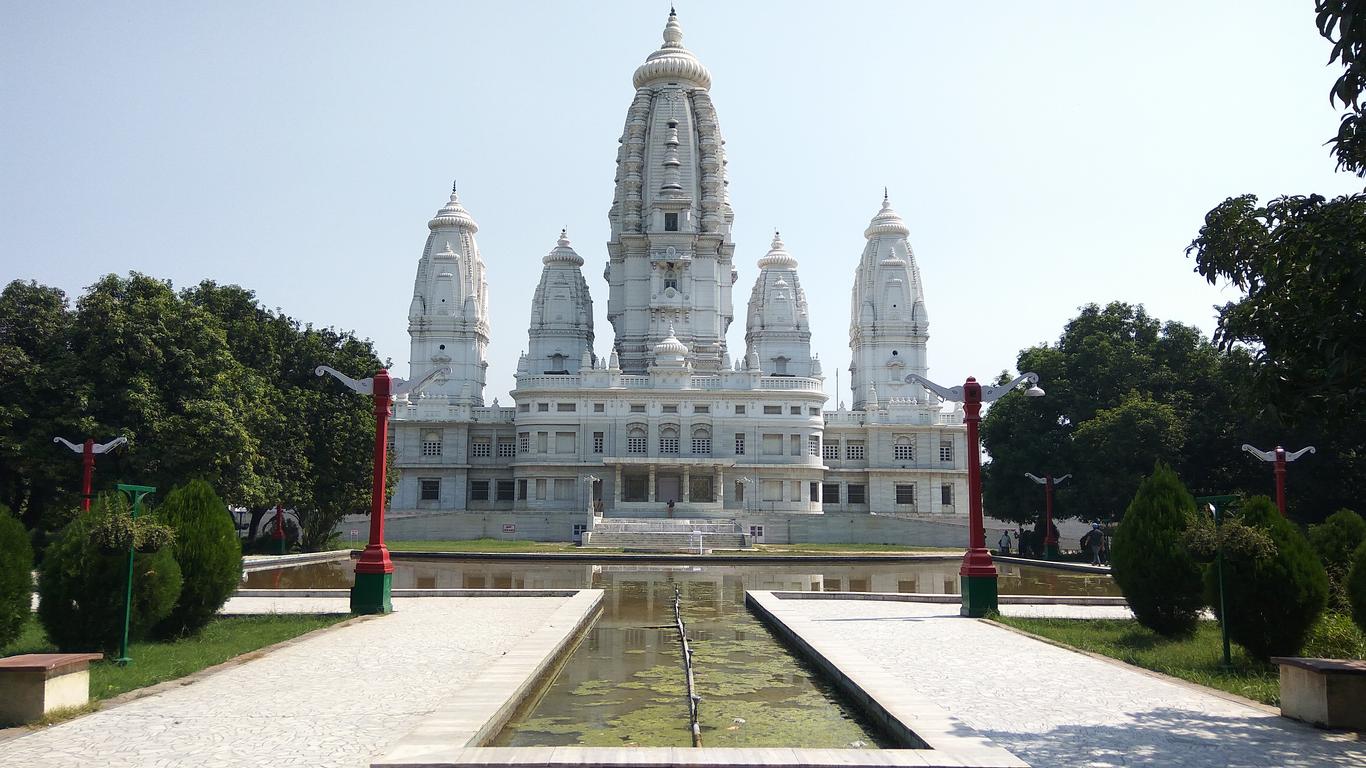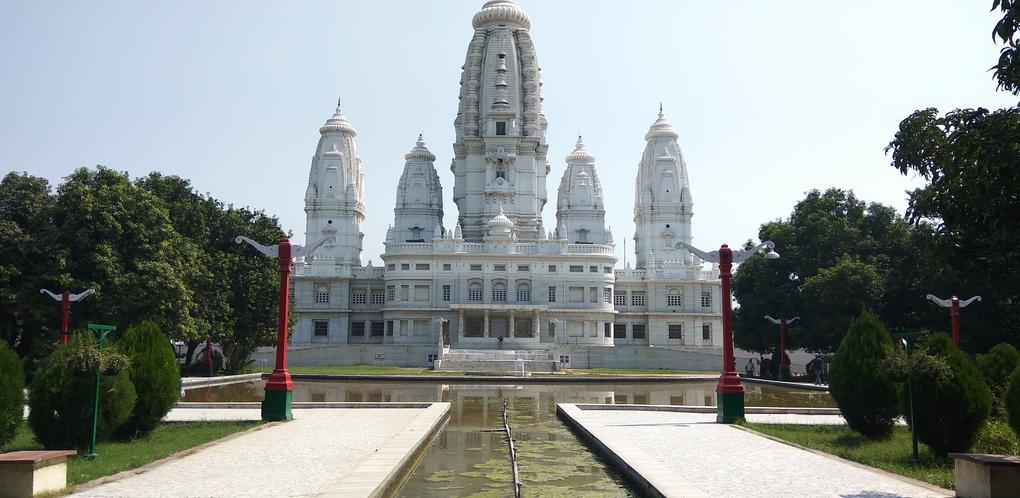
Kanpur travel guide
Kanpur Tourism | Kanpur Guide
You're Going to Love Kanpur
The northern Indian city of Kanpur is a great place to explore intricate Hindu temples, local market shopping and natural forest parks.

Top 5 Reasons to Visit Kanpur
1. Jain Glass Temple
This beautiful temple showcases intricate glass work and colorful paintings in a calm and peaceful setting.
2. Shri Radha Krishna Temple (JK Temple)
Hindus enjoy visiting this spiritual temple, which is a mix of both ancient and modern architecture.
3. Palika Stadium And Brijendra Swaroop Park
Many fairs, concerts and exhibitions take place in this community space located near to the JK temple.
4. Allen Forest Zoo
This 77 hectare zoo was created from a natural forest and is the largest green space in Kanpur.
5. Lal Bangla
The biggest and one of the cheapest outdoor markets, shops in this area are famous for selling locally made leather items.
What to do in Kanpur
1. A Tranquil Witness To History's Victims
Kanpur's major park has a fascinating history, and one which illuminates the nation's past like few other locations. After the "Indian Mutiny" of 1857, the British turned it into a memorial to British civilians who died in the uprising. When India gained independence, it became a memorial to the far greater number of Indians executed in the park by the British as punishment for the revolt. These days, the park is full of statues of independence icons and is a relaxing place to spend time.
2. A Monument To Modern Hindu Holiness
Located in the western part of central Kanpur, the Shri Radhakrishna Temple (also known as the J.K. Temple) is the city's most beautiful Hindu place of worship. It's also a testament to the desire to recreate sacred Hindu art and architecture in modern India. Although it looks centuries old, the temple only dates back to 1960. This means there is modern lighting and ventilation, while the five shrines retain a timeless feel in keeping with the holiness of the temple.
3. Ideal For Animal Addicts
Often referred to as Kanpur Zoo, Allen Forest can be found a mile or two northwest of the city center, clustered around a purpose built lake, and is a must for animal lovers. Laid out across 77 acres by a British scientist called, predictably, Sir Allen Forest, the zoo remains true to his ideal of a forest filled with wildlife, as close to their natural habitat as possible. Exotic species abound, including cheetahs, rhinos, leopards, jaguars, bears, hippos, and chimpanzees. Don't be alarmed if you stumble upon something far larger, as a series of dinosaur sculptures are also dotted around the park.
4. Go Hell For Leather To This Intriguing Suburb
Possibly Kanpur's most engaging suburb, Jajmau is situated a short distance southeast of the city center, on the banks of the Ganges. Its claim to fame is simple. For thousands of years, craftsmen in the area have been master leatherworkers, creating all kinds of clothing, armor, furnishings and more. If you want to pick up some recent products, head to Lal Bungla, the suburb's commercial hub, but it's worth exploring the whole area. From the twin temples of Siddhnath and Siddha Devi, to the digs at ancient Siddhapuri and the mausoleum of Sufi saint Makhdoom Shah Ala-ul-Haq, there's plenty to see.
5. Kanpur's Christian Hub
Kanpur's major Christian place of worship rounds off a tour of the town's diverse spiritual centers. It reflects modern India's inclusiveness, but is interesting in its own right. Located on Albert Lane, the church was erected by the British in 1875 - again as a memorial to the dead of the 1857 rebellion. Appearing more like a northern Italian cathedral than something on the Gangetic plain, it's a beautiful, if jarring, addition to the city's attractions.
1. A Tranquil Witness To History's Victims
Kanpur's major park has a fascinating history, and one which illuminates the nation's past like few other locations. After the "Indian Mutiny" of 1857, the British turned it into a memorial to British civilians who died in the uprising. When India gained independence, it became a memorial to the far greater number of Indians executed in the park by the British as punishment for the revolt. These days, the park is full of statues of independence icons and is a relaxing place to spend time.
2. A Monument To Modern Hindu Holiness
Located in the western part of central Kanpur, the Shri Radhakrishna Temple (also known as the J.K. Temple) is the city's most beautiful Hindu place of worship. It's also a testament to the desire to recreate sacred Hindu art and architecture in modern India. Although it looks centuries old, the temple only dates back to 1960. This means there is modern lighting and ventilation, while the five shrines retain a timeless feel in keeping with the holiness of the temple.
3. Ideal For Animal Addicts
Often referred to as Kanpur Zoo, Allen Forest can be found a mile or two northwest of the city center, clustered around a purpose built lake, and is a must for animal lovers. Laid out across 77 acres by a British scientist called, predictably, Sir Allen Forest, the zoo remains true to his ideal of a forest filled with wildlife, as close to their natural habitat as possible. Exotic species abound, including cheetahs, rhinos, leopards, jaguars, bears, hippos, and chimpanzees. Don't be alarmed if you stumble upon something far larger, as a series of dinosaur sculptures are also dotted around the park.
4. Go Hell For Leather To This Intriguing Suburb
Possibly Kanpur's most engaging suburb, Jajmau is situated a short distance southeast of the city center, on the banks of the Ganges. Its claim to fame is simple. For thousands of years, craftsmen in the area have been master leatherworkers, creating all kinds of clothing, armor, furnishings and more. If you want to pick up some recent products, head to Lal Bungla, the suburb's commercial hub, but it's worth exploring the whole area. From the twin temples of Siddhnath and Siddha Devi, to the digs at ancient Siddhapuri and the mausoleum of Sufi saint Makhdoom Shah Ala-ul-Haq, there's plenty to see.
5. Kanpur's Christian Hub
Kanpur's major Christian place of worship rounds off a tour of the town's diverse spiritual centers. It reflects modern India's inclusiveness, but is interesting in its own right. Located on Albert Lane, the church was erected by the British in 1875 - again as a memorial to the dead of the 1857 rebellion. Appearing more like a northern Italian cathedral than something on the Gangetic plain, it's a beautiful, if jarring, addition to the city's attractions.
Where to Eat in Kanpur
Antarang is a vegetarian Indian/Mughlai restaurant serving traditional kebabs and curries. Dinner prices average about INR1,500 for two people.
When to visit Kanpur
The best time to visit is between October and March, when the weather is mild and less-humid.
How to Get to Kanpur
Plane
The Kanpur Airport has sporadic and unreliable domestic flights from Delhi International Airport. A one-way ticket from London to Delhi costs roughly INR21,300.
Train
The Kanpur Central station has the highest amount of connections to other big Indian cities. The journey from Delhi takes between 4-6 hours and costs INR300 for a sleeper car.
Car
The National Highways of 2, 25, 86 and 91 pass by Kanpur. Road conditions should be taken into consideration during the rainy season of June-September.
Bus
The Jhakarkati Bus Station is the main station servicing Kanpur, with connections to the Indian cities of Delhi, Jaipur and Agra.
Airlines serving Kanpur
Where to stay in Kanpur
Motijheel Thana - This district is the center of business and commerce in Kanpur.
Popular Neighborhoods in Kanpur
Babu Purwa - Here you can visit one of several parks, houses of worship or shops at the Bakar Ganj market.
Jajmau - Located on the Gagnes river, here you can visit the ruins of the ancient city believed to be the kingdom of Emeror Yayati.
Where to stay in popular areas of Kanpur
Most booked hotels in Kanpur
How to Get Around Kanpur
Public Transportation
There are 300 buses serving Kanpur, with prices varying based on AC/non AC buses between INR5-20.
Rickshaw
This is the most common and cheap way to travel around Kanpur, with pre-set prices between destination points within the city.
Car
Daily rental prices start at around INR1,200, with pick-up locations at the central train station or downtown.
The Cost of Living in Kanpur
Shopping Streets
The Beconganj area has several boutique shops selling embroidered textiles and crafts. Z Square is the biggest and most central shopping mall covering 5 acres of space.
Groceries and Other
ABCD store and EazyDay Daily Needs Store are the main supermarkets selling food supplies. A dozen eggs cost INR62.
